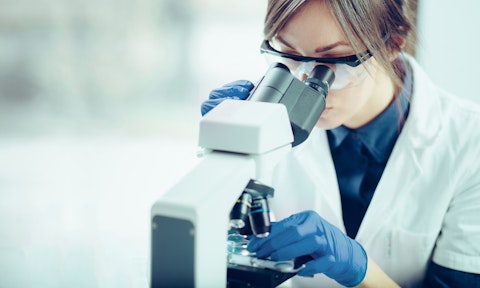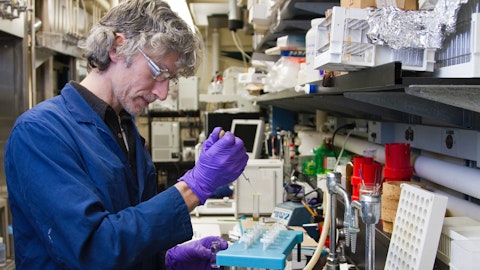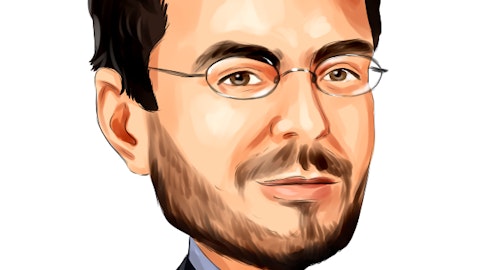Relmada Therapeutics, Inc. (NASDAQ:RLMD) Q3 2022 Earnings Call Transcript November 12, 2022
Operator: Good afternoon. My name is Kathy, and I’ll be your conference operator for today. At this time, I would like to welcome everyone to the Relmada Therapeutics, Inc. Third Quarter 2022 Earnings Call. All lines have been placed on mute to prevent any background noise. After the speakers’ remarks, there will be a question-and-answer session. And Brian Ritchie, you may begin your conference.
Brian Ritchie: Thank you, operator, and thank you all for joining us this afternoon. With me on today’s call are Chief Executive Officer, Sergio Traversa; and Chief Financial Officer, Maged Shenouda. This afternoon, Relmada issued a news release providing a business update announcing financial results for the three and nine months ended September 30th, 2022, and filed its quarterly report on Form 10-Q with the SEC. Please note that certain information discussed on the call today is covered under the safe harbor provisions of the Private Securities Litigation Reform Act. We caution listeners during this call that Relmada’s management team will be making forward-looking statements. Actual results could differ materially from those stated or implied by these forward-looking statements due to risks and uncertainties associated with the company’s business.

Likoper/Shutterstock.com
These forward-looking statements are qualified by the cautionary statements contained in Relmada’s press release issued today and the company’s SEC filings, including in the annual report on Form 10-K for the year ended December 31, 2021, and subsequent filings. This conference call also contains time-sensitive information that is accurate only as of the date of this live broadcast, November 10, 2022. Relmada undertakes no obligation to revise or update any forward-looking statements to reflect events or circumstances after the date of this conference call. Now I would like to turn the call over to Sergio. Sergio?
Sergio Traversa: Thank you, Brian, as always, and good afternoon to everyone. I’m pleased to welcome you to the Relmada third quarter 2022 conference call. During today’s call, I will provide an update on our ongoing late-stage RELIANCE clinical development program for REL-1017, our lead product candidate that we are currently studying as a novel treatment for patients with major depressive disorder, or MDD. Following my comments, Maged Shenouda, our Chief Financial Officer, will review our financial results and balance sheet, and we will then take your questions. As a reminder, RELIANCE I and RELIANCE II are two ongoing Phase 3 sister two-arm, placebo-controlled, pivotal studies evaluating REL-1017 25 milligrams as a potential adjunctive treatment for MDD.
RELIANCE III was the Phase 3 2-arm, placebo-controlled, registrational study evaluating REL-1017 25 milligrams as a potential monotherapy treatment for MDD. We announced topline results last month for RELIANCE III in which REL-1017 was administered for 28 days to 232 subjects. The study did not achieve the primary end point of a statistically significant improvement in depression symptoms, compared to placebo as measured by the MontgomeryAsberg Depression Rating Scale or MADRS, on day 28. In this study, the REL-1017 treatment arm showed a MADRS reduction of 14.8 points at day 28 versus 13.9 points for the placebo arm. This was an higher-than-expected placebo response. Paradoxical results were observed in certain study sites where placebo dramatically outperformed REL-1017.
To better understand the paradoxical result, a post-op exploratory analysis using the bandpass method, which excludes sites with unplausibly high or low placebo responses was conducted. In this study, an unplausibly high or low placebo response was defined as the mean decrease from baseline in MADRS 10 score greater than 14 and less than 3 points. The results of the bandpass analysis showed a meaningful difference between REL-1017 and placebo, greater than 12.9 points on the MADRS, representing a p-value below 0.05. It’s important to note that while we are pleased with the statistically significant difference seen using the bandpass method, we understand that this is not sufficient to be used as an FDA submission, and we may consider planning additional studies.
I want to highlight that in RELIANCE III, REL-1017 demonstrated very favorable tolerability and safety confirming the results of Phase 1 and Phase 2 studies with no opioid-like effect, no withdrawal effect and no psychotomimetic effect. While we are currently further evaluating the detail from RELIANCE III, we believe that the primary driver behind the study not being successful was the enrollment of subjects who are not truly suffering from MDD and responded dramatically and roughly to placebo. As an example of this, the top enrolling center had a mean change from baseline of 23 points in the placebo group. As we approach the topline readout for RELIANCE I expected before year-end, it is important to note that the higher enrolling centers in RELIANCE III also recruited significantly in RELIANCE I.
Mitigating that to some degree is the different patient population RELIANCE I, that is patients that enrolled and should already been diagnosed with depression and are not responding adequately to at least one and up to three courses of antidepressant therapy. We cannot predict how these factors will balance up. Looking further ahead, we intend to apply several plausible and operational changes in the current enrolling RELIANCE II study and make certain improvement to how the trial is being conducted. We now expect topline results from this study next year. Once we have finalized and determined how to best execute on this enrollment, we will provide a firmer timeline for topline results for RELIANCE II. Moreover, in order to be proactive and increase the likelihood of clinical success for REL-1017 as a potential therapy for MDD, an indication in which two successful studies are required to achieve FDA approval, we may consider initiating new clinical trials in 2023.
As we apply key learnings from RELIANCE III to improve how RELIANCE II is being conducted going forward, we focused on the four key pillars that mainly impact the success of an MDD trial: the protocol, the site selection, the patient selection and the rating process. We will integrate our key learnings in these areas into the RELIANCE II study and any possible additional study we may consider. Now let’s move on to RELIANCE-OLS, the long-term open-label safety study that is enrolling both rollover participants for all three pivotal studies as well as de novo participants. RELIANCE-OLS is ongoing and continues to involve participants as planned. Data from this long-term open-label safety study, which we now expect in first half of 2023, will be part of the planned NDA filing package.
Finally, I want to emphasize that RELIANCE III was a trial execution phase, and we remain highly confident in the potential REL-1017 to be a safe and effective new therapy for the treatment of MDD. It is important to note that we have the financial flexibility to continue advancing REL-1017 in the clinic due to our strong balance sheet. Maged will review our financials in detail shortly, but we ended the third quarter with cash, cash equivalents and short-term investments of approximately $124 million. With that, I will now turn the call over to Maged for a review of the financials. Maged, the stage is yours.
See also 10 Chamath Palihapatiya Stocks and 12 Best Beaten Down Stocks To Buy.
Maged Shenouda: Sure. Thank you, Sergio. Today, we issued a press release announcing our business and financial results for the three and nine months ended September 30, 2022, which I will now review. For the third quarter ended September 30, 2022, total research and development expense was approximately $30.5 million, as compared to $34 million for the comparable period of 2021. The decrease was primarily related to a decrease in stock-based compensation. This non-cash charge totaled $3.2 million in the most recently completed third quarter. Total general and administrative expense for the third quarter ended September 30, 2022, was approximately $8.2 million, as compared to $8.7 million for the comparable period of 2021, a decrease of approximately $0.5 million.
The decrease was primarily driven by a decrease in stock-based compensation. This noncash charge totaled $5.2 million in the most recently completed third quarter. For the third quarter ended September 30, 2022, the net loss was $39.4 million or $1.31 per basic and diluted share, compared to a net loss of $42.6 million or $2.44 per basic and diluted share in the comparable period of 2021. Turning to the results for the nine months ended September 30, 2022. Total research and development expense was approximately $86.5 million as compared to $65.3 million for the comparable period of 2021. The increase was primarily related to an increase in costs associated with the execution of a broader clinical program for REL-1017. For the nine months ended September 30, 2022, total general and administrative expense was approximately $36.1 million as compared to $26.2 million for the comparable period of 2021.
The increase was primarily driven by an increase in stock-based compensation. For the nine months ended September 30, 2022, the net loss was approximately $119.1 million or $4.04 per basic and diluted share compared to a net loss of $91.4 million or $5.36 per basic and diluted share in the comparable period of 2021. As of September 30, 2022, we had cash, cash equivalents and short-term investments of approximately $184.2 million compared to cash, cash equivalents and short-term investments of approximately $211.9 million at December 31, 2021. As Sergio mentioned, our current cash position provides us with ample runway or approximately two years of cash. I will now turn over the call to Sergio. Sergio?
Sergio Traversa: Thank you, Maged. Before taking your questions, I would like to share that we have on the call with us today the RELIANCE program principal investigator, Dr. Maurizio Fava, the Chairman of Harvard Psychiatry Department, that can answer questions regarding the REL-1017 clinical development. Thank you, Maurizio, for joining us.
Q&A Session
Follow Relmada Therapeutics Inc. (NASDAQ:RLMD)
Follow Relmada Therapeutics Inc. (NASDAQ:RLMD)
Maurizio Fava: My pleasure.
Sergio Traversa: With that, I will ask the operator to open the call for questions. Operator?
Operator: Thank you. And first, we will go to Marc Goodman of SVB Securities.
Guofang Li: Hey, thanks for taking my question. This is Rudy on the line for Marc. So on RELIANCE I that you expected in the first quarter, I’m wondering, are you making any changes to this study? What are your current plans to deal with the study size where placebo outperformed the drug? And did you take the FDA to get an agreement for your data analysis?
Sergio Traversa: Thank you for your question. Well, the RELIANCE I, it’s pretty much done. We are planning to close the database in the next two, three weeks. So we expect to have data before the end of the year. So it’s way too late to make any change. And now I noted in the opening remarks, there is some difference. The two factors in RELIANCE I that could make a difference. One is that the patient population is different. So these are patients not naive, not monotherapy. They’re patients that have been supposed to be diagnosed with depression. They have been taking at least one treatment for at least six weeks, and they are not responding adequately. So — and theoretically, and Dr. Fava can help us out on this topic, but theoretically, these patients would respond less to placebo.
On the other side, the sites and the operational issues that affected RELIANCE III are present, especially the sites that enrolled a large part of the patient in RELIANCE III are also enrolled in RELIANCE I. We don’t know how these two factors, one was it in its favor. The other one may not be in favor, how they will balance themselves. But it’s way too late to make any change. We want to see what the result will look like. And sorry, can you repeat the second part of your question?
Guofang Li: Yes. Just wondering what’s your current plan for data analysis? Is it going to be the same for like RELIANCE III?
Sergio Traversa: Yes. Yes, the same. We probably provide bandpass, but the bandpass is a very good diagnostic tool, and it tells you if the product works or not. But we think that the primary analogy will be the same as RELIANCE III with allcomers.
Guofang Li: Got it. That’s very helpful. Thank you.
Sergio Traversa: Thank you.
Operator: And next, we’ll take our question from Uy Ear of Mizuho.
Uy Ear: Hi, guys. Thanks for taking my question. Just wanted to get a better understanding of the — I guess the diagnostics or the tools that were used to assess the incoming patients in RELIANCE III, whether the tool captures some patients who are — have been chronically depressed or are episodically depressed? They’ve not really established sort of like a persistent state of depression. So that’s my first question. And I guess my second question is in RELIANCE I, I think you said the study is stopped. And could you tell us whether you enroll the expected number of patients and whether the DSMB has asked you to stop enrollment? Or is it — do you think it’s sufficiently powered? Just wanted to get a better sense of what’s going on there. Thanks.
Sergio Traversa: Sure. Thanks for the important question. Dr. Fava, you may take the first one, you help us how to analyze this data. So please go ahead. I will then answer the second question. Please go ahead.


